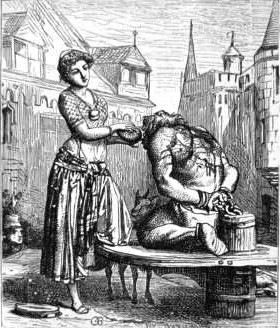
It’s Quasimodo Sunday!
That’s right, the Sunday after Easter is also known as Quasimodo Sunday, as explained below. But first, a note:
As soon as I can figure out all the bells and whistles – the confusing conglomeration of signs, symbols and icons on the webhostinghub.com dashboard – I’ll be commenting on a weekly basis on the upcoming Sunday Bible readings, as set out in the Revised Common Lectionary, the three-year cycle of Bible readings established by the Episcopal Church.
For example, the upcoming Sunday – the Sunday After Easter – is also known as “Quasimodo Sunday.” That’s aside from being known as Low Sunday and/or St. Thomas Sunday, or in some cases “Doubting Thomas” Sunday. I look forward to it.
The DOR* Scribe
Re: “Quasimodo Sunday.” (And no, that’s not me being given a drink by sweet Esmerelda in the image above, courtesy of Wikipedia. It’s the image titled, “Esmeralda gives a drink to Quasimodo in one of Gustave Brion‘s illustrations.”)
Now, the Sunday after Easter is perhaps best known as “Low Sunday,” because of the unusually-low church attendance that day, especially compared with the unusually high attendance on Easter Sunday. And it’s also known as St. Thomas Sunday, “because the Gospel reading always relates the story of ‘Doubting Thomas.'”
(That the story where Thomas the disciple comes to believe “only after being told by the resurrected Christ to place his finger in the nail marks and his hand in His side… In the Gospel accounts, this event takes place on the eighth day after the Resurrection, hence their significance for this Sunday.” (Wikipedia.)
But finally, the Sunday after Easter is also known as Quasimodo Sunday, but not through any connection with Victor Hugo’s character in The Hunchback of Notre Dame. Instead, the name comes from a Latin translation of the beginning of First Peter 2:2, a traditional “introit” used in churches on this day. First Peter 2:2 begins – in English and depending on the translation – “As newborn babes, desire the rational milk without guile…”
In Latin the verse reads: “Quasi modo geniti infantes…” Literally, “quasi modo means ‘as if in [this] manner.'”
So there you have it, the story behind Quasimodo Sunday.
* “DOR” stands for the Daily Office, a set of assigned Bible readings beginning on page 933 of the Episcopal Book of Common Prayer. (Thus “Daily Office Readings.”) By doing the readings on a daily basis, you can get through virtually the entire Bible in two years, and the psalms and Gospels three to four times.
That’s as compared with the Revised Common Lectionary (RCL), which sets out a three-year cycle of Bible readings. (“We” are currently in Year C.) Thus a devout 69-year-old Episcopalian, who has attended church faithfully since he was 21, will have heard the entire Bible read to him some 16 times, and the psalms and Gospels some 48 to 64 times.
Those assigned Bible readings will be the basis for the color commentary to follow in the upcoming posts.